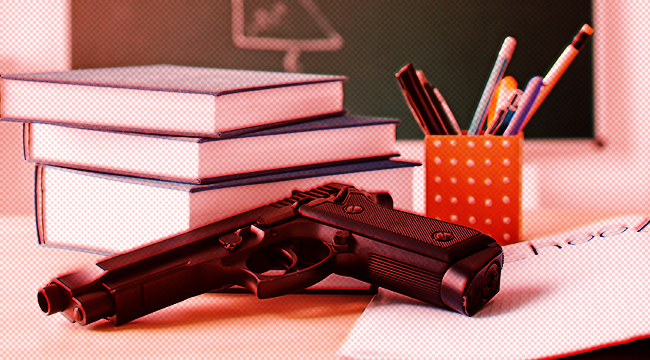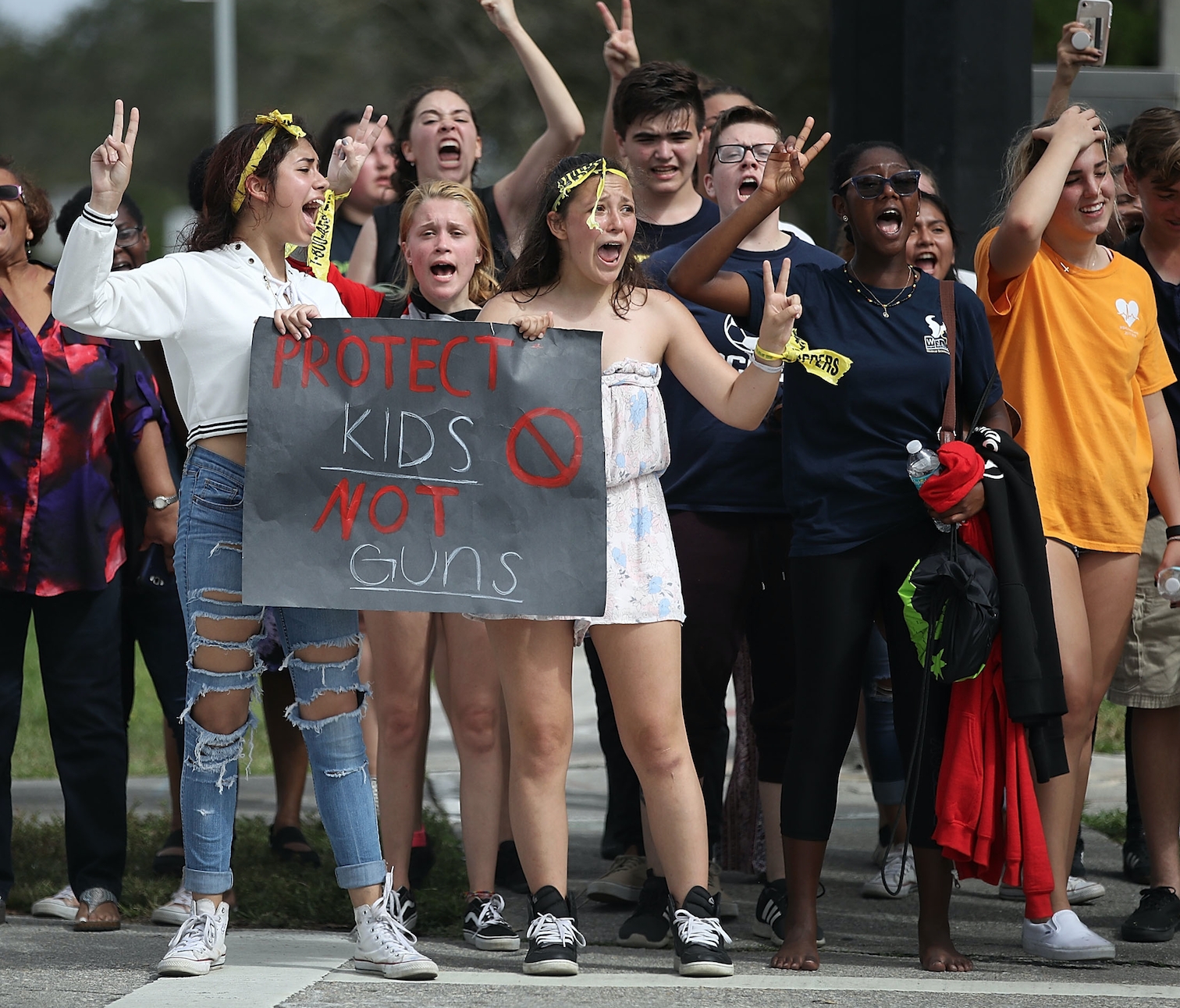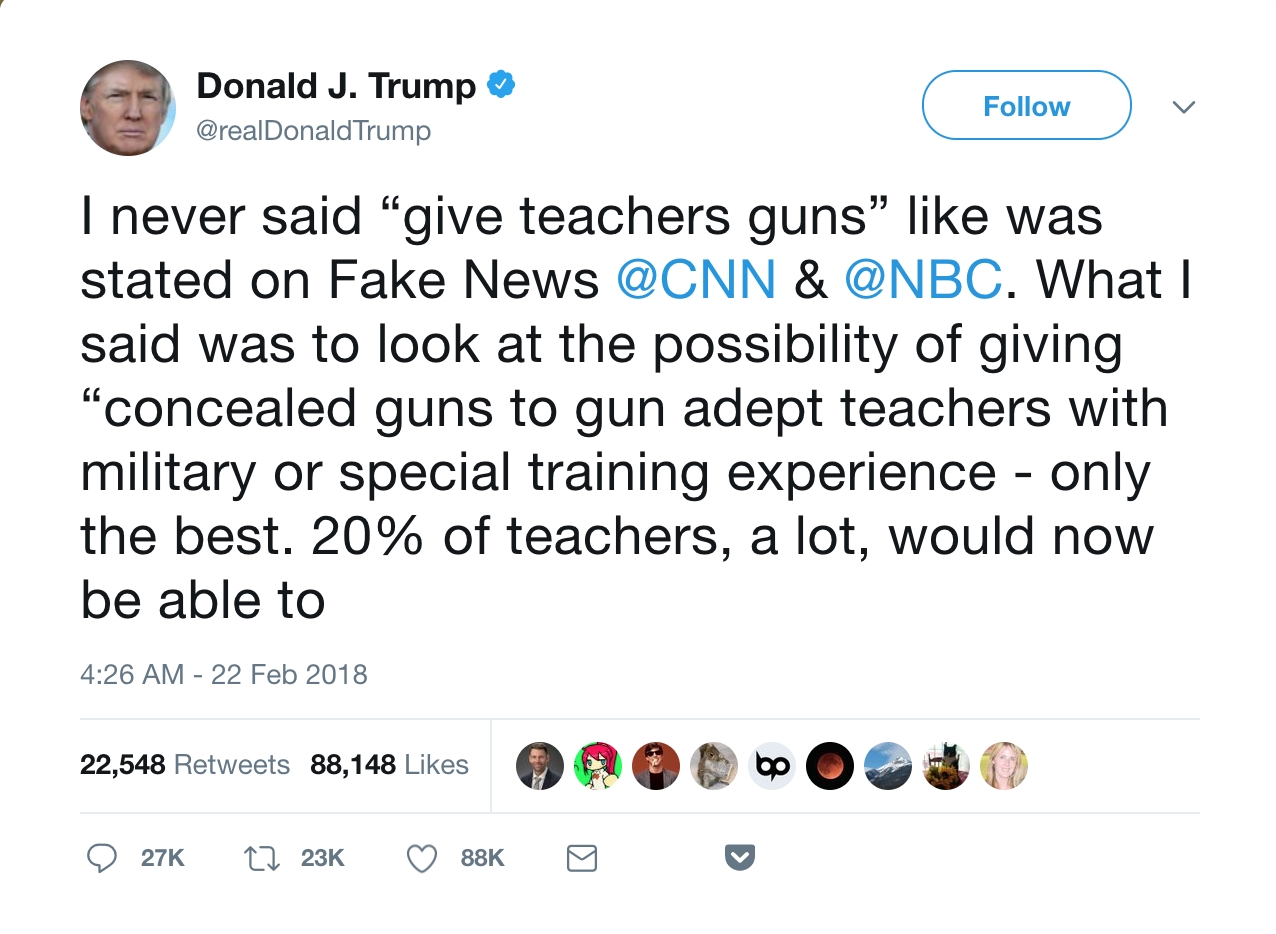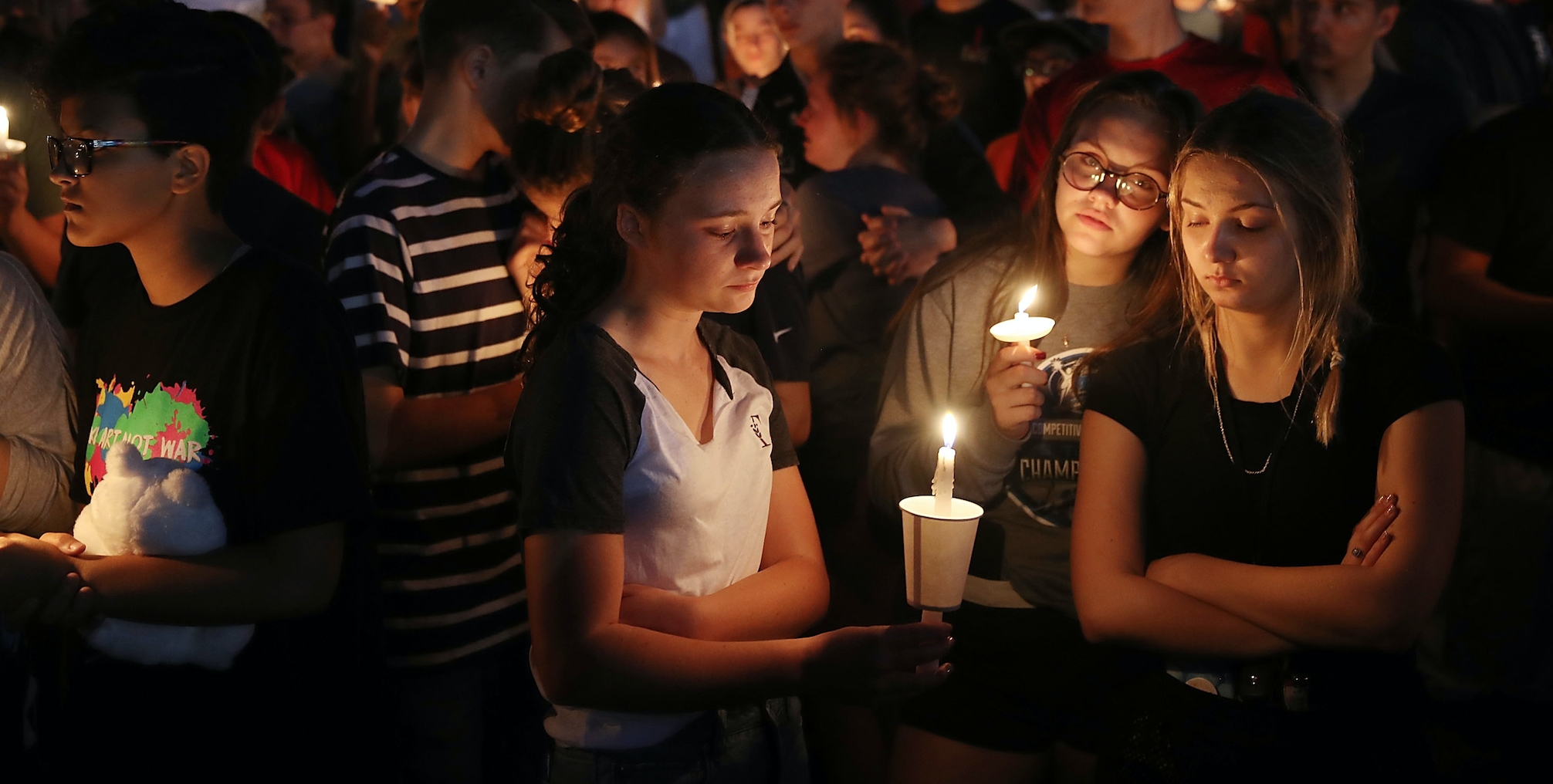
Let’s get something straight: No one is serious about arming teachers. Oh, over the past month the idea might have seemed serious. And it’s certainly been treated seriously. But it’s every bit as disingenuous as the “thoughts and prayers” of the NRA’s favorite elected officials. Serious ideas receive serious scrutiny and the proposal for arming teachers can’t hold up on that count. It can’t even hold up to casual scrutiny.
Have you seen the study on police gunfire accuracy rates? In NYC, only 43% of all shots fired within six feet hit their mark. Is it at all realistic to think that teachers would be any more effective? What about built-in prejudices? Wouldn’t teachers, like police, need anti-bias training? And when a teacher accidentally shot a student, would we — oh, look! It already happened! Will the teacher be fired? Jailed? Will students be wary of taking his class? Will his career be ruined for doing something the government sanctioned?
If you aren’t convinced of the silliness of the “give teachers guns” argument, you should note: There are roughly 90,000 grade and middle schools and 37,000 high schools in the US. The average high school has 750 kids. The average middle school has 600 kids. The average grade school has 450 kids. Let’s say — with extreme generosity — that every “good guy with a gun” can protect 150 kids. That’s five teachers with guns per high school, four per middle school, and three per grade school, totaling around 315,000 vetted, certified, and armed grade and middle school teachers (if you assume that there are roughly 45,000 of each type of school) and 185,000 vetted, certified, and armed high school teachers. Altogether, we’re talking about 500,000 armed teachers (this equals roughly 14% of the 3.6 million teachers in this country).
The margin for error skyrockets when you give guns to that many people. In fact, it’s been empirically proven that there’s a causal relationship between accidental shootings and gun availability. That point aside, when you talk about 500,000 armed teachers, the cost of training becomes wildly expensive. It does nothing to trace the problem back to even its most obvious root causes. It creates a situation where communities are divided because a beloved teacher failed to save a student or shot one in the crossfire or did not react in the way some might have hoped. Which means we need a system for managing these catastrophes when they crop up. An administration to make sure certifications and training are up to date. Plus an internal investigations unit to make sure that administration isn’t corrupt.
Suddenly we’d have more armed teachers in this nation than any single active branch of the U.S. military. And that’s before we even thought about arming college professors. We are, effectively, talking about a brand new government agency. And a massive one at that.
So… all we need, to make this idea a reality is half a million people with the aptitude for playing desperado when faced with an assault rifle. Should be easy enough to find — as long as they aren’t squeamish about blood like, say, the president of the United States.

Of course, you haven’t heard anyone in an elected position parse these statistics because the idea isn’t real. It’s just a smokescreen, meant to distract from the teen-led, actionable, common sense gun control conversation going on in our nation. Just look at how the president and smattering of senators who have surfaced the teachers-with-guns idea have refused to discuss the finances of it. They’ve blown right past the daunting practicalities. Instead, they’ve dropped soundbites and pulled publicity stunts — like a South Carolina House Republican who’s busy holding the world’s most disorganized gun raffle for teachers, in order to curry NRA favor as he mounts a re-election bid.
When politicians have real ideas they author bills and trade favors for support. They don’t wave their harebrained schemes around, then whip them away like matadors. Just look at the muddled relationship Donald Trump has had with arming teachers: When he floated the idea at the White House, he went just far enough to stir up the conversation, then backed away almost instantly, labeling it all a brainstorm:
I don’t want teachers to have guns. I want certain highly adept people — people that understand weaponry, guns. If they really have that aptitude — because not everybody has aptitude for gun — but if they have the aptitude, I think a concealed permit for having teachers and letting people know that there are people in the building with guns, you won’t have — in my opinion — you won’t have these shootings.
Even with the clarifications, when you watch the video of him defending the idea it still seems like he wants to give teachers guns. But apparently…

It doesn’t take a sociologist to recognize the distancing language in Trump’s tweet. The first sentence incriminates the “fake news” and essentially calls into question anyone who might take the president’s ideas at face value. “If they have the aptitude” is also pretty slick. It gives a big out when something goes wrong: “I guess that one didn’t have the aptitude.” Meanwhile, the 20% number reveals the lack of depth to which the president has thought this whole thing through.
That’s 720,000 armed teachers. More than double the National Guard.
In a campaign, it’s political suicide to be seen as a waffler. The fact that Trump is pinballing on this issue is a dead giveaway that it’s not something he really wants. (His decision to cede this massive policy move to the states is another form of distancing.)

And yet… We’ve been talking, as a nation, about giving teachers guns for days and days. We’ve been think-piecing this non-idea. Debating a measly bit of false flag fluff. Arguing over one of the most transparent smokescreens in the history of the gun control debate. And. It. Has. Absolutely. Worked. Because while a nation talks about giving teachers guns, and real teachers shoot real students with their guns, the measurable solutions that might progress the gun control conversation are forgotten.
Every time we hold this particular non-solution to the scrutiny we would hold less absurd suggestion to, we fail to do anything. And that, friends, is how they get you. That’s the trap. That’s the sly way that conversations get diverted, burning off their energy so that they never have the thrust to reach the stratosphere. It’s one of the NRA’s best tricks, every bit as shrewd as it is callous.
And the NRA might have gotten away with it too, if it weren’t for those blasted, meddling kids.
We are not walking out to disrupt education, we are walking out to protect it.#NeverAgain
— Ryan Deitsch (@Ryan_Deitsch) March 13, 2018
It may sound hyperbolic, but teenagers are poised to bring this conversation back into focus. Both with the National Walkout on March 14th and with the March for Our Lives on March 24, they will have a chance to reignite the push for sensible gun control, political accountability, and the sorts of logical measures that wouldn’t lead to a whole new government agency. Sure, we’re talking about students who are often too young to vote, but marches and protests have proven shockingly effective at raising collective consciousness and shifting conversations. If we look at last year’s Women’s March as a precursor to the #MeToo movement, it’s easy to wonder if the March for Our Lives might also lead to seismic change.
In this case, the change that is needed is policy, which has been famously hard to enact in the face of NRA opposition. But the teens speaking up after the Parkland Massacre have been epically clear about the policy changes they want to see. As New York Magazine laid out, their plans are realistic and unfold with a natural cadence:
Congress should lift funding limits, enacted in 1996, on CDC research into gun violence; records of gun sales should be digitized, so they can be better tracked; then universal background checks should be enacted; then limits on the sale of high-capacity magazines and, ultimately, all assault weapons.
Unlike arming teachers, those are practical, financeable, attainable goals. They make sense and they will receive some degree of partisan support. These ideas — asserted by teens — are exactly what the conversation has needed. Clear directives and straightforward messaging.
Between now and the March for Our Lives, teens have a chance to bring the real solutions of gun violence back into focus. They can seize the moment and take back the conversation. Talk of arming teachers was a distraction method pushed by adults. It’s both ironic and deeply satisfying that teens have proven un-distractable.
